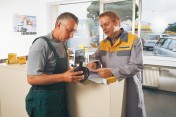PRETTY TIGHT CONDITIONS – THE LIEBHERR MK 140 MOBILE CONSTRUCTION CRANE PROVIDES THE BEST LOGISTICAL SOLUTION
Lifting three-tonne packages of roofing sheets to a height of over 20 metres in the tightest of spaces is both challenging and demanding. During the construction of a grocery distribution centre in Erlensee, Hessen, the Liebherr mobile construction crane succeeded in a job that others had previously been forced to decline.

With its 58.5-metre radius, the MK 140 serves the extensive roof area using only a minimal number of positions.
The location was chosen with careful consideration. Erlensee is a central logistics location – for Germany and the rest of Europe. Although the small town in the Main-Kinzig district of Hessen has just 15,000 inhabitants, its location close to the motorway, just 25 kilometres east of Frankfurt am Main, has led to Erlensee becoming a logistics hotspot within Europe. The short distances within Germany as well as to France, Spain, Benelux and Eastern Europe ensure a strong and steady flow of supply chains.
This is why the food retailer Lidl is now investing tens of millions of euros in building its new administration and logistics centre here. Around 120 branches operated by Lidl, one of Germany and Europe’s leading food retailers, are set to be supplied by the new distribution centre.
A 271-metre-long and 199-metre-wide complex is being built on an area of 61,814 m². As well as offices and administrative units, the centre will also house various storage areas, with temperatures ranging between -24 °C and +17 °C, to accommodate Lidl’s full range of products. In order to maximise storage capacities, the high-bay storage halls are built to a height of over 20 metres, making them significantly taller than the order picking areas.

Centre of attention – the MK 140 mobile construction crane in the centre of the new Lidl warehouse.
As is so often the case on large construction sites, the challenge here was in the detail. When the roof was completed, the distance between the reinforced concrete trusses of the support structure was around 6.5 metres for the majority of halls, but for the final ones this was reduced by a metre to 5.5 metres. This meant that things suddenly became very tight when the time came for cranes to lift insulation and roofing sheets. The limiting factor for a crane’s mobility in a confined space is the radius of the guying. And so it happened that site management had to deal with a number of declines from local crane companies in regard to lifting the three-tonne roofing sheets. Experts believed the use of a folding crane wasn’t possible. The machine solution for this unique structural challenge came from Liebherr.
But the right person for the job was also extremely important. Stephan Achenbach is the operator of an MK 140 Plus belonging to the crane rental company ADW Mobilkrane in Frankfurt am Main. This mobile construction crane is able to lift the required load of three tonnes up to the required radius of 40 metres with nine tonnes of additional ballast. “Our mobile construction crane allows us to be extremely flexible in our handling of tight, angular construction site situations,” says Achenbach. Having plenty of experience and a feel for construction sites provides an extra advantage, he believes. Working together with site management, the crane operator took a close look at the hall structure and came up with the solution.

A close thing – only a few centimetres lie between the tower and guy ropes and the concrete trusses.
“If the distance between trusses isn’t sufficient to swing 360 degrees, then operating with 180 degrees is the alternative,” explains MK operator Achenbach and continues, “To determine the radius of action for lifting heavy roof parts to a height of over 21 metres, I needed the exact measurement of the guy rope to the outer edge of the central tower section. After talking to Liebherr’s construction department in Biberach and taking precise measurements on site, it became clear to me that it was in fact possible.”
First, Stephan Achenbach determined the perfect location for the crane and its working range. To do this, he tied a cord from one concrete truss to the other and marked this clearly using a spray. “When the superstructure is turned 90 degrees, I need a distance of 1.7 m from the vehicle for the guying. And that was comfortably the case. So we were able to lift the three-tonne load onto the reinforced concrete trusses at a height of 21 metres without the tower coming into contact with the support structure,” he says, describing the almost surgically precise lifts. After 180 degrees of the roof area had been covered this way, the MK 140 Plus only had to be moved by 30 centimetres. “Our special steering programme meant that wasn’t a problem. The crane’s repositioning was complete in less than ten minutes.”

180° position change with only 30 centimetres of travel – not a problem thanks to the steering programmes.
Stephan Achenbach enjoys tricky assignments like this one. “The MK 140 Plus is a real all-rounder with excellent performance capacity.” The crane certainly proved this: 42 lifts of 3-tonne roofing sheets,126 tonnes in total, were achieved in two days. Stephan Achenbach is certain that had a telescopic crane been used for this work, it would have required multiple repositioning due to the long length of the packages and the high projecting edge. “Our MK mobile construction crane was at an advantage thanks to its geometry and mobile intelligence. We were able to lift the roofing sheets directly from the truck through the relevant opening to a height of 21 metres. That saved three days of work.”
This capacity for problem solving and flexibility went down well with the project management team in Erlensee. As site management told him afterwards, “If we’re told during similar future projects that crane operation isn’t possible without constant dismantling, we’ll show them the pictures – that it can be done with creativity and the use of good technology.”
May 2021


